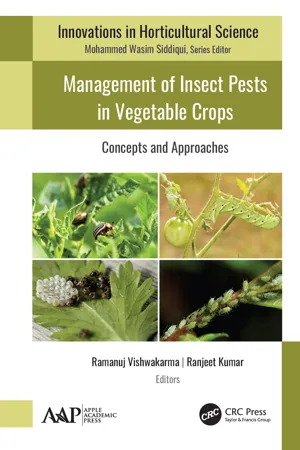
Management of Insect Pests in Vegetable Crops
Concepts and Approaches
- 320 pages
- English
- ePUB (mobile friendly)
- Available on iOS & Android
Management of Insect Pests in Vegetable Crops
Concepts and Approaches
About This Book
This new book on the sustainable management of insect pests in important vegetables offers valuable management strategies in detail. It focuses on eco-friendly technology and approaches to mitigating the damage caused by insect pests with special reference to newer insecticides. Chapters in the volume provide an introduction to vegetable entomology and go on to present a plethora of research on sustainable eco-friendly pest management strategies for root vegetables, spice crops, tuber crops, and more.
Vegetable crops that are infested by several insect pests from the nursery to the harvesting stage cause enormous crop losses. Given that it is estimated that up to 40 percent of global crops are lost to agricultural pests each year, new research on effective management strategies is vital. The valuable information provided in this book will be very helpful for faculty and advanced-level students, scientists and researchers, policymakers, and others involved in pest management for vegetable crops.
Frequently asked questions
Information
CHAPTER 1
ECO-FRIENDLY PEST MANAGEMENT STRATEGIES OF ROOT VEGETABLE CROPS
KALMESH MANAGANVI1*, RAMANUJ VISHWAKARMA1, and JABA JAGDISH2
ABSTRACT
1.1 INTRODUCTION
1.2 PESTS OF NATIONAL SIGNIFICANCE OF ROOT VEGETABLES
Common name | Scientific name | Family | Order |
|---|---|---|---|
1. Potato | |||
Tuber moth | Phthorimaea operculella | Gelechiidae | Lepidoptera |
Colorado potato beetle | Leptinotarsa decemlineata | Chrysomelidae | Coleoptera |
Green peach aphid, potato aphid | Myzus persicae Macrosiphum euphorbiae | Aphididae | Hemiptera |
Cutworm | Agrotis ipsilon | Noctuidae | Lepidoptera |
Hadda beetle | Henosepilachna vigintioctopunctata (Epilachna vigintioctopunctata) | Coccinellidae | Coleoptera |
2. Carrot | |||
Aster leafhopper | Macrosteles quadrilineatus | Cicadellidae | Hemiptera |
Flea beetle | Systena blanda | Chrysomelidae | Coleoptera |
Willow carrot aphid | Cavariella aegopodii | Aphididae | Hemiptera |
Green peach aphid | Myzus persicae | ||
Carrot Weevil | Listronotus oregonensis | Curculionidae | Coleoptera |
Carrot rust fly | Psila rosae | Psilidae | Diptera |
Cutworm | Agrotis spp. | Noctuidae | Lepidoptera |
3. Radish | |||
Diamondback moth | Plutella xylostella | Yponomeutidae | Lepidoptera |
Aphids | Myzus persicae | Aphididae | Hemiptera |
Root maggots | Delia radicum | Anthomyiidae | Diptera |
Black cutworm | Agrotis ipsilon | Noctuidae | Lepidoptera |
Granulate cutworm | Feltia subterranea | ||
4. Yam | |||
Scale insect | Aspidiella hartii | Diaspididae | Hemiptera |
San Jose scale | Quadraspidiotus perniciosus | Diaspididae | Hemiptera |
Mealy bugs | Geococcus coffeae, Planococcus citri, Phenococcus gossypii | Pseudococcidae | Hemiptera |
Vine borers | Apomecyna saltator | Cerambycidae | Coleoptera |
Wood boring beetle | Clytocera chinospila | Cerambycidae | Coleoptera |
Leaf eating beetles | Galerucida bicolor, Lema lacorelairei, Crioceris impressa | Galerucidae | Coleoptera |
Yam tuber beetle | Heteroligus meles, H. appius | Dynastidae | Coleoptera |
White grub | Leucopholis coneophora | Scarabaeidae | Coleoptera |
Coffee bean weevil | Araecerus fasciculatus, A. laevigatus | Anthribidae | Coleoptera |
Termite | Odontotermes escherichi | Termitidae | Isoptera |
Tussock caterpillar | Dasychira mendosa | Lymantriidae | Lepidoptera |
Leaf feeder | Ansioarthra coerulea | Tenthredinidae | Hymenoptera |
Yam nematode | Hoplolaimus spp., Scutellonema Bradys | Hoplolaimidae | Secernentea |
Root-knot nematode | Meloidogyne spp. | Heteroderidae | Secernentea |
5. Sweet potato | |||
Sweet potato weevil | Cylas formicarius | Curculionidae | Coleoptera |
West Indian sweet potato weevil | Euscepes postfasciatus | Curculionidae | Coleoptera |
Sweet potato stem borer | Omphisia anastomasalis | Pyralidae | Lepidoptera |
Sweet potato butterfly | Acraea acerata | Nympalidae | Lepidoptera |
Tortoiseshell beetle | Aspidomorpha spp | Chrysomelidae | Coleoptera |
Sweet potato hornworm | Agrius convolvuli | Spingidae | Lepidoptera |
Armyworms | Spodoptera eridania S. exigua, S. litura | Noctuidae | Lepidoptera |
6. Cassava | |||
Scale insect | Aonidomytilus albus | Diaspididae | Hemiptera |
Cassava green spider mite | Mononychellus tanajoa | Tetranychidae | Acari |
Cassava mealy bug | Phenacoccus manihoti | Pseudococcidae | Hemiptera |
Cassava lace bug | Vatiga illudens | Tingidae | Hemiptera |
Cassava whitefly | Bemisia tabaci, Aleurodicus disperses | Hemiptera | Aleurodidae |
7. Sugar beet | |||
Sugar beet root Aphid | Pemphigus populivenae | Aphididae | Hemiptera |
Beet webworm | Spoladea recurvalis | Crambidae | Lepidoptera |
Beet leafhopper | Circulifer tenellus | Cicadellidae | Homoptera |
8. Elephant foot yam | |||
Mealy bug | Rhizoecus amorphophalli, Pseudococcus longispinus, P. citriculus | Pseudococcidae | Hemiptera |
Aphids | Lipaphis erysimi, Aphis gossypii | Aphididae | Hemiptera |
Red cotton bug | Dysdercus cingulatus | Pyrrhocoridae | Hemiptera |
Leaf eating beetle | Galerucida bicolor | Gallerucidae | Coleoptera |
Leaf eating | Pericallia ricini | Arctiidae | Lepidoptera |
caterpillars | Spodoptera littoralis | Noctuidae | Lepidoptera |
Theretra gnoma | Sphingidae | Lepidoptera |
1.2.1 POTATO TUBER MOTH (PTM): PHTHORIMAEA OPERCULELLA (GELECHIIDAE: LEPIDOPTERA)
Table of contents
- Cover
- Half Title
- Title Page
- Copyright Page
- Dedication
- Innovations in Horticultural Science
- Books in the Series
- About the Editors
- Table of Contents
- Contributors
- Abbreviations
- Acknowledgment
- Preface
- 1. Eco-Friendly Pest Management Strategies of Root Vegetable Crops
- 2. Insect Pests of Ginger and Turmeric and Their Management
- 3. Insect Pests of Cumin and Their Management
- 4. Insect Pests of Cucurbitaceous Vegetables Crops
- 5. Phytophagous Mites of Vegetable Crops and Their Management
- 6. Mite Problems in Spice Crops and Their Management
- 7. Pesticide Residue in Vegetables
- 8. Insect Pests of Tomato and Their Management
- 9. Insects of Tuber Crops and Their Management
- 10. Problems of Snails and Slugs in Vegetable Crops and Their Management
- Index